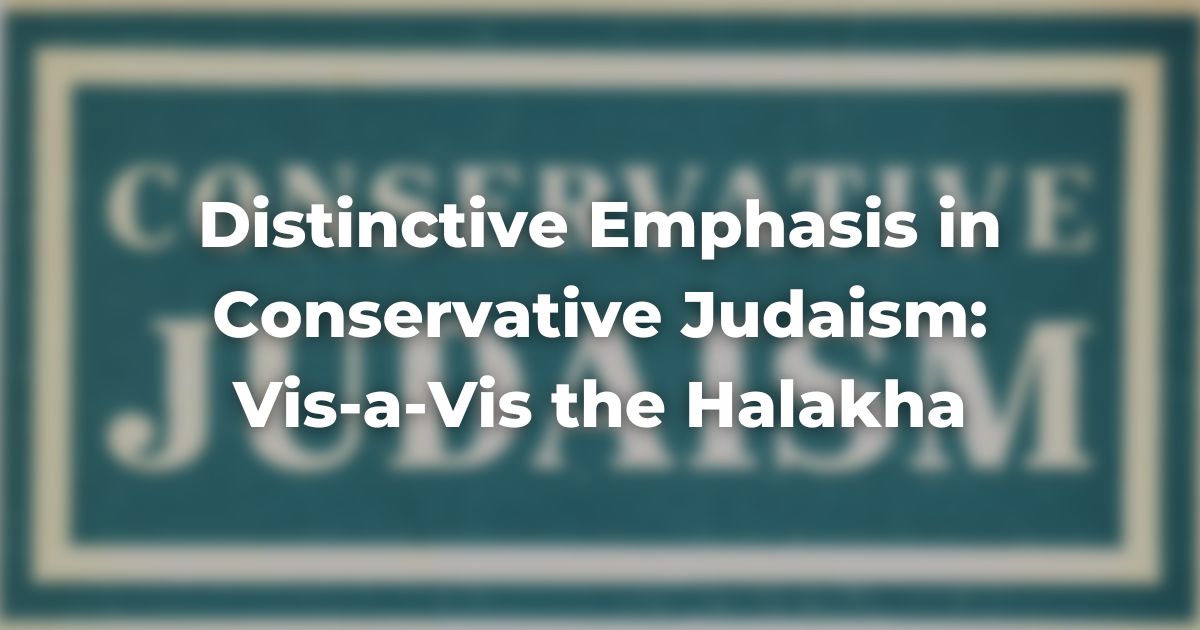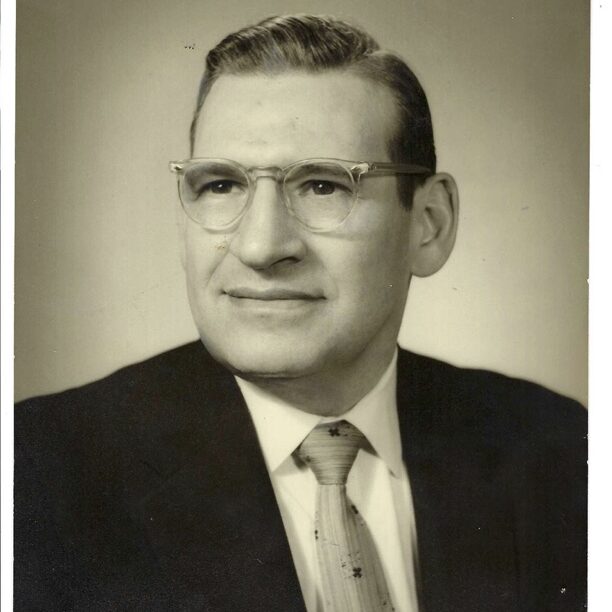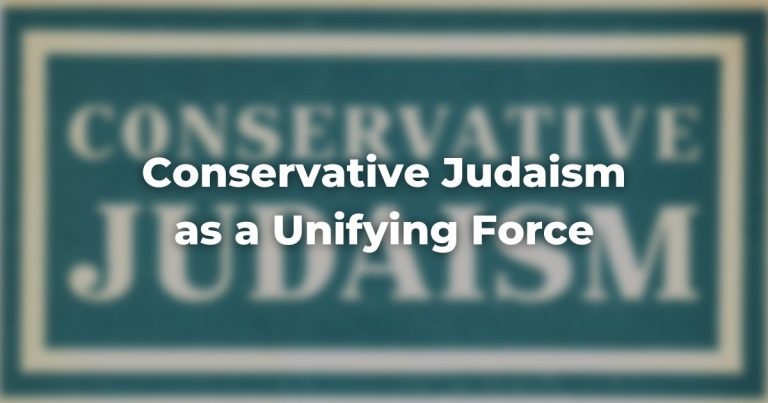This is a part of our “Core Conservative Judaism Ideas” series and believe this piece offers something substantial to the understanding of Judaism and Conservative Judaism.
This article was published in the Conservative Judaism academic journal, a publication of the Conservative Movement that ran from 1945-2014 that reflected the some of the many voices of the movement, and was recently relaunched as Masorti Journal.
This piece was written by Rabbi Max L. Forman z”l in in 1952. The language and style may reflect the time it was written.
The piece has been reformatted for readability and edited for length. The full article with footnotes is available for those who wish to read it. Headings added by the editor.
Editor’s Summary of Main Points
In order to discern a philosophy of Conservative Judaism, the first step is define where there is agreement.
First point of agreement: “It seems to me that the Halakhah is the peculiar and unique method which the Jewish people has devised throughout its history for its religious discipline. The Halakhah was the tool by which life in its personal and human relationships was elevated and ennobled, was rendered sensitive to the divine, and responded to it.”
Second point of agreement: “Virtually all of us envisage Judaism as a way of life based on Halakhah. Without Halakhah, Judaism cannot function; indeed, without religious authority and discipline Judaism is no longer Judaism.”
Third point of agreeement: “the Halakhah is indispensable because it affords a link, perhaps the strongest link, with the past. There must be a continuity between Jewish life of today and yesterday.”
Fourth point of agreement: “the Halakhah is evolutionary in character. Change has always been characteristic of Jewish law. The Halakhah was ever sensitive to changed conditions in life, whether social, economic, moral, or spiritual.”
“Our task, vis-a-vis the Halakhah, is to strike the proper balance between continuity with the past and the urgencies of the present. This is a never-ending task, for as an instrument of the life of the spirit, the Halakhah must be adjusted to the changing needs of every age.”
The goal is not to create a code of law that “would in time result in the substitution of one frozen code for another. We are led rather to the formulation of a dynamic approach to Jewish law; not to a corpus or platform, but to a methodology. Just as we do not look upon the minutiae of the Halakhah as divine, but rather upon the concept of “Halakhah” itself, so do we consider, not the laws and practices of any given age as eternal, but rather direct attention to the method and approach of their evolution.”
“We must trace every Halakhah to its inception, analyze the purpose for which it came into being, what historical forces, economic, social, or political, influenced them. If these purposes are not valid today, or these forces ineffective, then we should have no compunction in declaring these Halakhoth obsolescent and inoperative today.”
“If this historical method and approach be followed with regard to our Halakhah, we shall be, no doubt, violently opposed by the literalists of our time. In this, we shall be paralleling the experience of the Rabbis of the Talmud…May I dare to suggest that we can strengthen ourselves with the thought that we are the Pharisees of our day in our attempt to liberalize and interpret the Halakhah…We shall, furthermore, have the satisfaction of knowing that we have examined the Halakhah, arrived at a sound approach, and established the Conservative point of view.”
Distinctive Emphasis in Conservative Judaism: Vis-a-Vis the Halakha (1952)
In approaching the subject of “The Distinctive Attitude of Conservative Judaism to the Halakhah,” we inevitably come to the question, “What is Conservative Judaism?” What is distinctive about it? Is there a single point of view that can serve as a point of departure for a discussion of the place of the Halakhah within it?
There is a plethora of descriptive terms for our particular approach to Judaism, all testifying to a lack of agreement on our part and reflecting the whole gamut of attitudes ranging from those of extreme traditionalists on the right to liberals on the left. There are even those who threaten secession if the point of view of the latter is adopted by our national body.
The same divergence is to be noted in our Committee on Jewish Law and Standards. Our Assembly prides itself on its arrangement of issuing majority and minority reports in its Halakhic responsa: that it is a sign of our strength that we can encompass and serve such a wide field of differences.
However, far from being an indication of strength, it betrays only weakness to say that in a moot question of Halakhic practice one can follow the majority or the minority as one pleases. This is only adding the stamp of “authority” to each one’s established practice, encouraging dichotomy, and leaving the status quo. אם כן מה כה בית דין יפה. What has our Committee on Jewish Law accomplished, besides arranging on each side a number of Poskim, preserving the differences with a quasi-legality? We cannot be sanguine enough to believe that on any point that really matters there will be a unanimous report from our Law Committee.
Furthermore, what is a majority report today could easily have been a minority point of view, and vice versa, had the composition of the Committee, through the appointments of the men to serve on it, been different.
Focusing on Agreement
We must, therefore, cease emphasizing and glorifying our differences, as though there were some special merit in such diversity. We are only mistakenly applying to the field of Law the democratic principle of diversity of opinion and freedom of expression. There must be authority and discipline even in a democracy, when it comes to Law.
The Law cannot permit any man the right to choose which laws he shall obey and which he shall disobey. The right to entertain either a majority or a minority point of view may be defensible in the realm of thought and belief, but society cannot long exist where freedom of choice of conformance or nonconformance is extended to Law.
Our first step, then, is to discover our points of agreement, and to go on from there to a clearly defined philosophy.
Such a philosophy will never come about by waiting for isolated She’eloth to be sent to the Committee for decision. As a matter of fact, such decisions for want of a definitive philosophy will only betray self-contradiction and illogic.
Thus, for example, Doctor Boaz Cohen, in presenting the view of his committee, does not object to the practice of mixed pews, but is strongly opposed to the use of the organ. He states, “The stand of the Committee is based not merely in obedience to the letter of the law, but because of the highly dubious nature of the spiritual returns in exchange for the abandonment of a long-cherished tradition.”
But wherein is the separation of the sexes at worship less a “long-cherished tradition” than the forbidding of the organ? As a matter of fact, historically it is much older! We must suspect, therefore, another criterion for permitting mixed pews — shall we say, the necessity for legitimizing a universal practice which it would be futile to proscribe?
Furthermore, in a divinely revealed law — a theological proposition which Dr. Cohen invariably uses to start his discussions of Jewish law — there can be no distinction between one din and another. In a strict, consistent adherence to Law, there is no justification for the criterion of “spiritual returns.” Would Dr. Cohen want to extend this principle to all of Jewish law? Accepting this principle, for instance, would solve immediately the problem of the hapless agunah.
The Points of Agreement
What are our points of agreement? For one thing, most Conservative Rabbis do not hold to the belief that the Bible is literally the word of God. Rather are the Holy Scriptures conceived either as “the word of God in the sense that it reflects the human striving after wisdom and goodness,” or as “a record of the moral and religious evolution of the Jews.”
This unequivocably implies that the Halakhah, which is based upon the Bible, is shorn of its supernatural origin. What, then, is Halakhah? Can we do without it? If not, wherein does its authority lie?
It seems to me that the Halakhah is the peculiar and unique method which the Jewish people has devised throughout its history for its religious discipline.
The Halakhah was the tool by which life in its personal and human relationships was elevated and ennobled, was rendered sensitive to the divine, and responded to it. The Halakhah had authority in the past because it was sanctioned as the people’s way of life, and it will still have validity if it is sanctioned by present Jewry.
This brings us to the second consideration upon which we Conservative Rabbis seem agreed. Virtually all of us envisage Judaism as a way of life based on Halakhah. Without Halakhah, Judaism cannot function; indeed, without religious authority and discipline Judaism is no longer Judaism.
Hence, even though we may not subscribe to the view that God dictated the TorahRefers to the first five books of the Hebrew Bible, the Tanakh, also called the Five Books of Moses, Pentateuch or the Hebrew equivalent, Humash. This is also called the Written Torah. The term may also refer to teachings that expound on Jewish tradition. Read more to Moses, word by word and letter by letter, together with the interpretations and elaborations of the Oral Law, we still are agreed that the Law possesses prime significance for us.
We cannot build our Judaism on a solid foundation, if we do not see clearly the validity and vital essence of Jewish law. To deny this is to fall into the error of Reform while trying to escape the cul-de-sac of Orthodoxy.
Our third point of agreement flows from the second: that the Halakhah is indispensable because it affords a link, perhaps the strongest link, with the past. There must be a continuity between Jewish life of today and yesterday.
Without this continuity, there would be no more resemblance of the Judaism of the present to that of the past than the civilization of the modern Greek or Italian resembles that of classical Greece or Rome. Ties to our people in the dimension of time are as necessary as those in the dimension of space. Folly, indeed, it would be if we were to discard as irrelevant today the Halakhah which embraces the best spiritual efforts of our people for several thousands of years!
I believe that the fourth point of agreement among us is that the Halakhah is evolutionary in character. Change has always been characteristic of Jewish law. The Halakhah was ever sensitive to changed conditions in life, whether social, economic, moral, or spiritual. The Halakhah was life, and the Jews were never left for long floundering in a vacuum where there was no law to provide for new exigencies and new challenges.
However, the mere desire for change will not solve our problem of revitalizing Jewish life in America. What change is healthy, and what change is dangerous?
I believe that we Conservative Rabbis are agreed that we do not want to start a new religion. We do not want the Halakhah changed merely to suit our convenience. We do not want a Halakhah whose purpose is only to justify or legitimitize of the manner of observance or lack of observance in our congregations.
We do not want a Halakhah that does not foster Jewish religious consciousness, that is not in the spirit of our highest ethical and social values.
Our task, vis-a-vis the Halakhah, is to strike the proper balance between continuity with the past and the urgencies of the present. This is a never-ending task, for as an instrument of the life of the spirit, the Halakhah must be adjusted to the changing needs of every age.
The Implications of the Agreements
Our points of agreement, then, lead us not to the compilation of a new Shulhan Arukh, lenient and liberal, free from the restrictions and “injustices” under which some of our Rabbis chafe. A Shulhan Arukh d’amerika, as acceptable as it might be at the moment, would in time result in the substitution of one frozen code for another.
We are led rather to the formulation of a dynamic approach to Jewish law; not to a corpus or platform, but to a methodology. Just as we do not look upon the minutiae of the Halakhah as divine, but rather upon the concept of “Halakhah” itself, so do we consider, not the laws and practices of any given age as eternal, but rather direct attention to the method and approach of their evolution.
It is this methodology that I should like to sketch briefly: one to which, I believe, the Conservative movement can subscribe.
The Methodology and Historical Judaism
From the various appellations that have been coined to describe our Judaism, “historical Judaism” is the one that suits best my approach. This term was, strangely, enough, incorporated in the very constitution of the Jewish Theological Seminary, when it was reorganized in 1902. It is there set forth that the Seminary is dedicated “to the preservation in America of the knowledge and practice of historical Judaism, as ordained in the law of Moses and expounded by the prophets and sages of Israel in Biblical and Talmudic writings.”
I daresay that the formulators of this constitution intuitively or unconsciously put their finger upon what must be true nature of Conservative Judaism.
Unfortunately, the implications of this term, historical Judaism, have not been clearly defined or even seriously examined. We are justified, however, in implying from this definition of the Seminary’s purpose that historical, or Conservative Judaism holds that the Bible and the TalmudReferring to one of two collections, the Jerusalem and Babylonian Talmuds, edited in the 6th century, that contains hundreds of years of commentary, discussion, and exploration of the ideas in the Mishnah. One could describe it as Mishnah + Gemara = Talmud Read more are the final authorities in its Halakhah.
A serious study of the history of the Halakhah will prove, as Professor Ginzberg has often pointed out, that the Talmud, from the Gaonic period on, has been considered such a final authority. This has been explicitly stated and implicitly assumed by all Jewish legal writers.
When the various codes were subsequently compiled, their purpose was not so much authoritarian as utilitarian, — to facilitate the finding of the Halakhah without scanning all of Talmudic literature, easing the determination of the Halakhah in cases of controversy, and supplementing new decisions that had been reached in the course of time.
Hence, according to historical Judaism, we are not bound to give unquestioned allegiance to the Shulhan Arukh, nor to the Rambam, the Semag, the Semak, or any other code.
If this authoritarian character of the Shulhan Arukh and other codes are thus denied, there is at one stroke cut away all necessity for ascribing finality to it or yielding unreservedly to all the com mentaries, glosses, and superglosses thereon. Their usefulness would consist in their being a guide or a point of view. It is back to the Talmud that the historical method takes us, for it is there that Judaism was fashioned and created;it is there that it received the stamp of its character.
As an illustration of what is meant by the historical method, as opposed to that of complete submission to the Shulhan Arukh, there may be cited the ritual immersion of a female proselyte. The law is laid down in the Yoreh Deah, 268:2, that a geyoreth must undergo tevilah in the presence of three men, — a most indelicate situation.
This din can be traced back to Rambam, Issurei Biah 9:6 and it is not to be found in the Talmud, or, for that matter, in authorities prior to Maimonides. The Talmudic source for tevilah for proselytes is Yevamot 47b: 2-3: for a male convert, the requirement is ושני ת״ח עומדים על גביו, while for a woman נשים משיבות אותה במים עד צואדה ושני ת״ח עומדים לה מבחוץ.
The historical method would permit us, without second thought, to revert to the Talmudic practice, especially since it is in line with our current moral sensibilities.
The Broader Impact on Halakhah and Examples
A single instance, however, does not constitute a technique or philosophy.
What is done here must be done for the entire scope of Jewish law which still applies today. We must trace every Halakhah to its inception, analyze the purpose for which it came into being, what historical forces, economic, social, or political, influenced them. If these purposes are not valid today, or these forces ineffective, then we should have no compunction in declaring these Halakhoth obsolescent and inoperative today.
This historical principle would apply to the whole field of the Halakhah, the sources of which are the following: the Written Law, the Oral Law, Gezerah, Takanah, and Seyag.
The written Law was, of course, the basis for all Halakhah. However, it underwent great modification by interpretation and legal fiction. The sages even went so far as to say that in three places the Halakhah uproots the Scripture (‘Afar, Ta־ar, and Sefer), while others declared that some of the Biblical laws applied only during the time of Moses and were not meant for posterity.
This daring on the part of the Rabbis to interpret and suspend the Biblical law — revelation notwithstanding — certainly should encourage us in a similar approach, keeping in mind the canons of our interpretation, the strengthening and preserving of Jewish life in America.
As far as the Oral Law, as codified in the Mishanh, is concerned, we are all familar with its treatment at the hands of the Amoraim in the GemaraThe discussion portions of the Talmud based on the quoted Mishnah. Read more. The Gemara had to establish the purpose for which the Mishnaic law came into being; establish the authorities and sources; reconcile contradictions; interpret and limit (בד״א ,הכא במאי עסקינן, and אימתי). Tannaitic laws were at times suspended, in spite of the fact that Amoraim were presumed to have no right to contradict a Tannaitic authority: as הלכה ואין מורין כאן.
The Gezerah is independent legislation by a recognized authority. Such a decree was promulgated by the authority of the Beth Din or by its head, because of a particular circumstance or need.
When the reason or the need for the decree disappeared, it automatically became void. Thus the decree of Jose b. Joezer and Jose b. Johanan that the land of the pagans were in a state of tumah. This decree, issued during the Maccabean struggle, was designed to prevent Jews from emigrating from Palestine, and at the same time to eliminate the rivalry of Onias’ Temple in Alexandria with the one in Jerusalem. When these dangers were removed, the gezerah automatically disappeared.
This explains why the same decree was issued no less than three times — again by Beth Shammai and Beth Hillel, and later by the Rabanan deshemonim Shanah. The reason was not that the people did not accept the decree at first, as the Gemara puts it, ;מעיקרא גזור ולא קיבלו מיניהו, ואתו רבנן רשמנים שנה וגזרו וקיבלו מיניהו but that the decree had become null and void when the reason for it had vanished. When the need arose again, the later sages reissued the decree.
This historical approach would lead us to re-examine every gezerah in Jewish law, with regard to establishing its validity in modern Jewish life.
Another source of the Halakhah is the Takanah — an amendment of early law, whether Written or Oral, introduced by the sages generally for the purpose of harmonizing religion and life. Hence a takanah has a tendency toward leniency. It was introduced either by the method of interpretation, or legal fiction, or both. Thus we have the takanot of the Erub, Ketubah, Prosbul. The only requirement was that the takanah must be supported by a Biblical verse.
There are several thoughts to be developed with regard to our analysis of the takanah. Where the takanah defeats its own purpose and causes severity instead of relief, it should be suspended.
Even the Talmud recognizes this in giving a person the right to reject the takanah, אי אפשי בתקנת חכמים. If the takanah becomes a burden, we can ask with the Talmud, אם כן מה ?הועילו חכמים בתקנתן The necessity also for the attachment to a Biblical verse ought to be a clue as to the shaky foundation of the takanah, powerful though it was in molding Jewish life to new conditions. The idea that it is an אסמכתא בעלמא ought to make it easier for us to nullify the takanah when it has outlived its usefulness and no longer applied to life.
The Seyag is a fence around the law, introduced in order to prevent the possibility of transgressing the law. This principle influenced many Tannaitic Halakhot, although not actually mentioned by name. Thus Hullin 104b, where Beth Hillel differs with Beth Shammai as to העוף עולה עם הגבינה על השלהן.
All such “fences” have to be analyzed critically to establish whether they are valid today. This includes every הומרא and שמא, which in a sense, may be considered a form of gezerah.
Minhag (Custom) and Specific Cases
For purposes of completeness, a final source of law, the Minhag or popular usage must be mentioned, although it had no effect upon Talmudic Halakhah. These minhagim did not become part of the formal law. They were only the custom of a particular group (like shippers, מנהג ספנים) or locality (מנהג העיר).
Although some believe that a minhag sometimes nullifies a Halakhah, there should be no hesitation in eliminating these minhagim when necessary.
An historical examination of the Talmudic period will yield a most important difference between the Tannaitic and Amoraic periods. In the Tannaitic period, the law was actually practised. The Amoraic period found the Law mostly theoretic: the Law could not be practised because of external conditions of persecution and oppression.
The Tannaim never laid down any principles of law; they only decided individual cases. In Amoraic times, study consisted mainly of deriving principles of law, which they projected backwards, מאי טעמא דפלוני. But it is precisely these principles that are so important for us in our historical approach: כל דמקדש על דעתא דרבנן מקדש הפקר ב״ר הפקר ברירה; and many others. These principles must form the basis of the Halakhah of our time.
The Societal Impact
If this historical method and approach be followed with regard to our Halakhah, we shall be, no doubt, violently opposed by the literalists of our time. In this, we shall be paralleling the experience of the Rabbis of the Talmud who did not have an easy time in the establishment of their interpretations of the Scriptures. In their endeavor to make the Oral Law supreme, they were opposed by the literalists of their time, the Sadducees.
May I dare to suggest that we can strengthen ourselves with the thought that we are the Pharisees of our day in our attempt to liberalize and interpret the Halakhah, while the orthodox and the followers of their camp are the Sadducees of our day, clinging to the literal exposition of the Shulhan Arukh and the narrow construction of the Law?
Even if beki’ut or harifut rests with these opponents of ours — and we do have men in our movement who would not suffer by comparison with them — nevertheless, we ought to feel free, for the good of Judaism, for its future and preservation, to decide against them, just as Rabbi Judah did, when he decided that he could not permit the Halakhah to agree with the view of R. Meir, even though he was admittedly the outstanding scholar of his day.
On the other hand, it is possible, even probable, that in our historical analysis of Jewish law, we shall find many, if not most, of the Halakhot coinciding with the decisions of the Shulhan Arukh. That may be all to the good, since then we shall not lose the traditional cast of Jewish life, but shall establish its continuity with the ages.
We shall, furthermore, have the satisfaction of knowing that we have examined the Halakhah, arrived at a sound approach, and established the Conservative point of view.
Of course, there are situations today which could not be anticipated or provided for in Talmudic days.
For new circumstances, we certainly can trust the decisions and good judgment of our Committee on Jewish Law and Standards (with emphasis on the “Standards”), and the intuition of our own people: הנה להם לישראל, אם לאו נביאים הם, בני נביאים הם. Where even Hillel forgot the Halakhah concerning the carrying of the knife for slaughtering the paschal lamb on the eve of Passover which coincided with the Sabbath, the advice was to go out and see what the practice of the people was.
If it is true that no legislation is valid if it is not acceptable to the people (witness the Torah itself), it is likewise true that where there is no precedent or decision on the basis of historical experience, a practice that is acceptable to the people should be valid.
The Halakhah, in the last analysis, is more than logic or even justice. As the prophet has said, וארשתיך לי בצדק ובמשפט ובחסד וברחמים. There must be also lovingkindness, sympathetic understanding, and compassionate treatment of our people, and it is with these qualities that we must approach their way of life and revitualize Halakhah in our time.
Adapted from the Conservative Judaism journal.
Author
-

Rabbi Max Leon Forman was born in Albany, New York in 1919 into a family with a long and illustrious lineage of Rabbis. He was raised in Philadelphia and awarded a four year scholarship to the University of Pennsylvania where he was an All-American fullback on the Penn Soccer team. He played semi-professional soccer while earning his Rabbinical degree at the Jewish Theological Seminary, and later awarded an honorary Doctor of Divinity. His first pulpit was in Petersburg, Virginia then assumed the leaderships at B’Nai Aaron in Philadelphia, Hollis Hills Jewish Center in Queens, NY, retired but then encouraged to unretire and lead Temple Emanuel in Palm, Beach, Florida. The author of several books, including Rx for Living, which predated the inspirational Chicken Soup series. He married Diana Slavin, herself an author, sociologist and creator of the world-famous Bible Dolls. Together their raised four children, Gayl, Cyrelle, Barr and Donna. Rabbi Forman was an inspiration teacher and speaker, who often gave his sermons in English, but also in Yiddish and Hebrew. Rabbi Forman succumbed in 1991 after a lengthy illness.
View all posts






